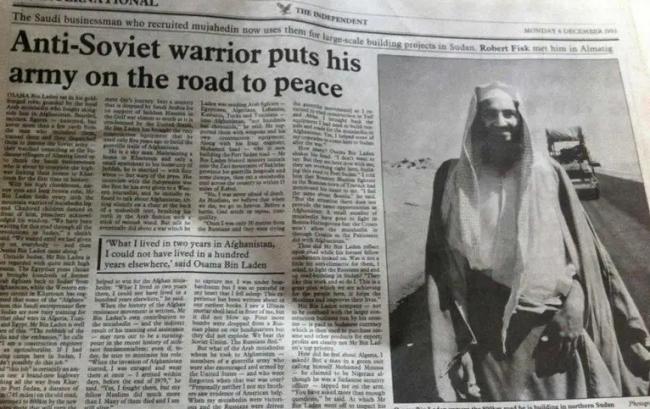美國宣傳機構、新聞和娛樂媒體總能在適當時候推出適時的口號。比如好萊塢當年火爆全球的大片《第一滴血之阿富汗》結尾就在巨屏上打出一行耀眼紅字:僅以此片獻給伊斯蘭主義聖戰鬥士。
賓拉登作為伊斯蘭主義聖戰鬥士的精神領袖那會兒不但是西方眼裡為自由而戰的化身,更享受到被西方濾鏡媒體記者拍攝成先知般模樣的超豪華待遇。

好萊塢前些年與時俱進,偷偷把《第一滴血之阿富汗》片尾獻詞改了,不再獻給伊斯蘭主義聖戰鬥士,一片兩用,改獻阿富汗人民。
美國花錢養仇人的事多了,但以色列扶持仇人成長壯大的事卻鮮有提及。周末我看到《華盛頓郵報》幾年前的一篇文章,溯源以色列和哈馬斯恩怨。
雖然西方記者報導以色列時總能很自覺地表現出政治正確,可欲言又止,欲語還休,字裡行間仍會有些許真情流露。我大約翻譯一下,原文附最後。

以色列如何幫助創建哈馬斯
華盛頓郵報,2014年7月30日
所有跡象表明,以色列總理班傑明-內塔尼亞胡正準備為摧毀已被戰火搞得破爛不堪的加薩走廊的伊斯蘭民兵組織哈馬斯展開長期戰爭。
持續戰亂讓當地死傷慘重,2008至2009年以色列對加沙的轟炸和地面攻擊,三個星期就至少有1383名巴勒斯坦人被殺。
為了讓藏身地下的巴勒斯坦民兵組織徹底失去戰鬥力,內塔尼亞胡從連接加沙讓哈馬斯滲透進以色列的地道下手。
但戰鬥中頑強成長起來的哈馬斯卻在破壞內塔尼亞胡的計劃。哈馬斯發言人在星期二說,「內塔尼亞胡的威脅嚇不倒哈馬斯和巴勒斯坦人民」。
相比於哈馬斯武裝分子,以色列軍事擁有碾壓性優勢,可目前的衝突卻讓以色列和巴勒斯坦所面對的挑戰充滿不確定性。比如在巴勒斯坦獨立建國已不可能之刻,如何解決占領區數百萬巴勒斯坦人能享有平等權利這類棘手問題。
哈馬斯的奇特歷史充滿迷幻。過去幾個星期向以色列狂射飛彈的伊斯蘭組織軍事武裝哈馬斯在某種程度上其實應該為自己的存在而感謝以色列。
1988年拒絕承認以色的臭名昭著的巴勒斯坦人民大起義爆發,哈馬斯於此時在加沙成立。之後十幾年裡以色列政府一直允許他存在。
當時以色列的主要敵人是已故亞瑟-阿拉法特的法塔赫,其核心即為巴解組織。世俗的法塔赫跟冷戰時代在世界各地武裝暴動的其他左翼游擊隊解放運動如出一轍,在周邊阿拉伯國家支持下搞暗殺綁架。
巴解組織被以色列視為恐怖組織,在占領區承受著以色列的殘酷鎮壓。
與此同時,跟在埃及被禁止的穆斯林兄弟會相關聯的伊斯蘭運動卻在加沙被允許公開活動,這明顯跟世俗化的埃及總統那薩爾政府管理加薩走廊時的政策背道而馳。
1967年巴以戰爭以色列占領約旦河西岸,並從埃及奪取加沙。埃及總統那薩爾已於1966年處決了穆斯林兄弟會智囊領袖之一的薩伊德-庫賽布。以色列卻認為可以用庫賽布在巴勒斯坦占領區的追隨者,坐著輪椅的亞辛,制衡阿拉法特的巴解組織。
「現在回看那一系列事件,我認為我們犯了錯」,在2009年和《華爾街時報》記者安德魯-海金絲訪談時一位上世紀八十年代在加沙工作的以色列官員表示,「但那個時候沒人知道可能有什麼後果。」
海金絲的文章值得全文閱讀。他一一列舉了以色列在一開始給予亞辛的各種幫助。當時亞辛,和加沙地區的其他伊斯蘭主義分子一樣,在巴解組織眼裡都是以色列的「合作者」。
以色列加沙軍管政府對亞辛這位癱瘓的牧師充滿好感,幫亞辛在加沙建學校,診所,幼兒園和圖書館。以色列認定亞辛成立的伊斯蘭主義組織,伊斯蘭查經會,為慈善機構,在1979年將其視為一個協會。
以色列贊同亞辛創立的加沙伊斯蘭大學現在已被認為是軍事好鬥分子的溫床,在2008-2009年以色列發動的「鑄鉛行動」中這所大學是以色列戰機首批轟炸的目標。
亞辛旗下的一個組織就是哈馬斯。有人說哈馬斯就是以色列的塔利班。因為哈馬斯和塔利班都是伊斯蘭主義組織,都發源於西方在對抗左派敵人時對他們的扶持。
1984年以色列將藏有武器的亞辛逮捕,並判處12年徒刑。但一年後就將其釋放,因為以色列當時還有更讓他們擔憂的其他敵人。
後來風向變了。1993年奧斯陸協議達成,以色列正式承認巴解組織,開啟了我們現在所說的和平進程。於是哈馬斯就成了以色列的黑色野獸。
哈馬斯拒絕接受以色列、拒絕放棄暴力,並開始引領以色列占領區巴勒斯坦人民的抵抗運動。哈馬斯之所以能獲得巴勒斯坦民眾的持續支持,遠非他們的宗教理念,主要原因是他在引領以色列占領區的巴勒斯坦抵抗運動。
2004年亞辛死於以色列空襲。2007年,哈馬斯通過一場合法的民主選舉獲勝,伊斯蘭主義組織從此掌控加沙,這讓西方和法塔赫巴解組織都惱羞成怒。結果就是以色列開始封鎖加沙,煉獄般的衝突再次循環往復。
但是,就像伍德羅-威爾斯中心中東專家艾倫-大衛-米勒觀察的那樣,以色列和哈馬斯之間卻又一種奇怪的、能自我維持的關係存在。
米勒寫道,以色列鷹派政府中對巴勒斯坦獨立建國毫無興趣的那些政客關注哈馬斯冷酷的飛彈對以色列的安全威脅,而哈馬斯的「意識形態和策略也需要對抗和抵抗來維持」。
米勒總結說,以色列鷹派政府和哈馬斯,「看上去二者無法共存,可很明顯他們卻又誰也沒法離開對方而單獨存在。」
How Israel Helped Create Hamas
All signs indicate that the government of Israeli Prime Minister Benjamin Netanyahu is prepared to wage a protracted battle in the battered Gaza Strip as it seeks to crush the capabilities of the Islamist militant group Hamas. The ongoing conflict has already exacted a bloody toll, with the Palestinian death count approaching the total of Israel's2008-2009 bombing campaign and ground offensive in Gaza, which led to the deaths of at least1,383 Palestinians over three weeks.
Netanyahu wants to wholly demilitarize the Palestinian enclave, beginning with the network of tunnels that allow Hamas's fighters to infiltrate into Israeli territory. But Hamas, a dogged outfit that thrives in wartime, is digging in its heels. On Tuesday, a Hamas spokesman said Netanyahu's"threats did not frighten Hamas or the Palestinian people."
The current fighting— a clash between Israel's vastly superior armed forces and Hamas's insurgents— obscures the greater challenges facing Israelis and Palestinians, including the thorny question of how to accord equal rights to millions of Palestinians living under occupation in the event that a separate Palestinian state turns out not to be viable.
It also obscures Hamas's curious history. To a certain degree, the Islamist organization whose militant wing has rained rockets on Israel the past few weeks has the Jewish state to thank for its existence. Hamas launched in1988 in Gaza at the time of the first intifada, or uprising, with a charter now infamous for its anti-Semitism and its refusal to accept the existence of the Israeli state. But for more than a decade prior, Israeli authorities actively enabled its rise.
At the time, Israel's main enemy was the late Yasser Arafat's Fatah party, which formed the heart of the Palestinian Liberation Organization(PLO). Fatah was secular and cast in the mold of other revolutionary, leftist guerrilla movements waging insurgencies elsewhere in the world during the Cold War. The PLO carried out assassinations and kidnappings and, although recognized by neighboring Arab states, was considered a terrorist organization by Israel; PLO operatives in the occupied territories faced brutal repression at the hands of the Israeli security state.
Meanwhile, the activities of Islamists affiliated with Egypt's banned Muslim Brotherhood were allowed in the open in Gaza— a radical departure from when the Strip was administered by the secular-nationalist Egyptian government of Gamal Abdel Nasser. Egypt lost control of Gaza to Israel after the1967 Arab-Israeli war, which saw Israel also seize the West Bank. In1966, Nasser had executed Sayyid Qutb, one of the Brotherhood's leading intellectuals. The Israelis saw Qutb's adherents in the Palestinian territories, including the wheelchair-bound Sheik Ahmed Yassin, as a useful counterweight to Arafat's PLO.
"When I look back at the chain of events I think we made a mistake," one Israeli official who had worked in Gaza in the1980s said in a2009 interview with the Wall Street Journal's Andrew Higgins."But at the time nobody thought about the possible results."
Higgins's article is worth reading in full. He goes on to outline the type of assistance the Israelis initially gave Yassin, whom the PLO at one time deemed a"collaborator," and Gaza's other Islamists:
Israel's military-led administration in Gaza looked favorably on the paraplegic cleric, who set up a wide network of schools, clinics, a library and kindergartens. Sheikh Yassin formed the Islamist group Mujama al-Islamiya, which was officially recognized by Israel as a charity and then, in1979, as an association. Israel also endorsed the establishment of the Islamic University of Gaza, which it now regards as a hotbed of militancy. The university was one of the first targets hit by Israeli warplanes in the[2008-9 Operation Cast Lead].
Yassin's Mujama would become Hamas, which, it can be argued, was Israel's Taliban: an Islamist group whose antecedents had been laid down by the West in a battle against a leftist enemy. Israel jailed Yassin in1984 on a12-year sentence after the discovery of hidden arms caches, but he was released a year later. The Israelis must have been more worried about other enemies.
Eventually, the tables turned. After the1993 Oslo accords, Israel's formal recognition of the PLO and the start of what we now know as the peace process, Hamas was the Israelis' bete noire. Hamas refused to accept Israel or renounce violence and became perhaps the leading institution of Palestinian resistance to Israeli occupation, which, far beyond religious ideology, is the main reason for its continued popularity among Palestinians.
Yassin was killed in an Israeli airstrike in2004. In2007, after a legitimate Hamas election victory that rankled both the West and Fatah, the Islamist group took over Gaza— a move that led to strict Israeli blockades and the grinding cycle of conflict that is once more repeating itself.
But, as Aaron David Miller, a Middle East expert at the Woodrow Wilson Center, observes, a strange, self-sustaining relationship remains. Israel's hawkish government— comprising many politicians who have little interest in seeing the creation of a separate Palestinian state— dwells on the security threat that Hamas's crude rockets pose. Hamas depends, Miller writes, on"an ideology and strategy steeped in confrontation and resistance."
And so, he concludes, they are"two parties who can't seem to live with one another— or apparently without one another either."


















